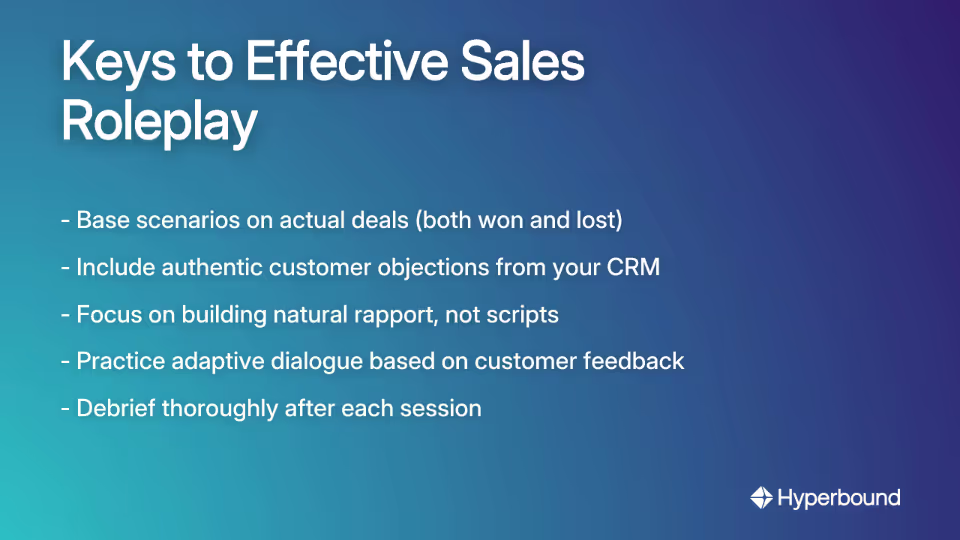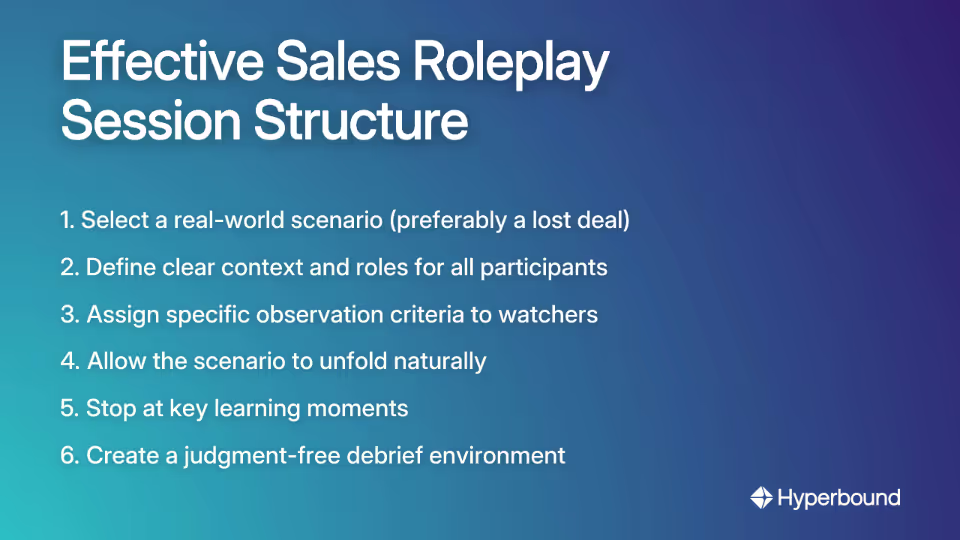.avif)
Let's be honest. For many in sales, the mere mention of "roleplay" triggers a collective groan. It feels "freaking awkward," like a "waste of time," and is often perceived as a drill "designed to make you do something wrong." If you've sat through these stilted exercises where someone pretends to be an impossibly cooperative prospect who follows your script to the letter, you know the frustration.
But here's the truth: The problem isn't practice itself—it's the quality of that practice.
When done right, roleplay offers SDRs and account executives a safe space to master objection handling without risking real prospects. Unfortunately, most sales teams are stuck in a cycle of ineffective roleplay that bears little resemblance to actual sales conversations, creating a dangerous gap between training and performance.
This article provides a framework for transforming roleplay from a cringeworthy task into a powerful tool for closing deals. We'll show you how to stop faking it and start creating realistic scenarios that build real skills that translate to success on actual discovery calls and client pitches.
Why Your Current Roleplay Feels Like a Waste of Time
The "Ideal Scenario" Trap
Most roleplay sessions "cover ideal scenarios where there is an obvious answer." This creates a false confidence that evaporates during real cold calls. When faced with unexpected objections about your value proposition or pricing that weren't covered in training, reps freeze or resort to awkward, canned responses.
This approach is particularly frustrating for tenured reps who need to "get rough and tumble" and "practice how you play," not run through basic "softballs" that offer little challenge.
Lack of Realistic Pushback
As one sales professional put it, "Most assigned roleplay partners don't do it well. As in, they aren't pushing the 'no' realistically." Without authentic resistance, reps develop a distorted view of the sales process and struggle when faced with genuine objections.
This problem creates a dangerous baptism by fire for new reps who step into their first real sales conversations completely unprepared for the tough questions and objections they'll face. The negative reinforcement of failing on real calls after "succeeding" in roleplay can damage confidence and performance.
The Performance Gap
When reps are trained on unrealistic scenarios, they can't adapt to different customer personas or handle unexpected objections. The result? Lost opportunities, missed buying signals, and diminished lead generation effectiveness.
Effective roleplay should be an "improvised dramatic enactment to explore responses, build empathy, and develop skills in handling real-life situations," not a recital of perfect scripts from your pitch deck.
The Framework for Realistic Roleplay: From Theory to Practice

The foundation of effective roleplay is simple: build your scenarios from reality, not imagination. Here's how to create practice sessions that actually prepare your team for success:
The Foundation
- Base Scenarios on Real Deals: Use actual sales experiences—both won and lost—to construct your scenarios. Analyze your sales process for the moments where deals typically stall or advance.
- Incorporate Real Customer Objections: Mine your CRM, call recordings, and team knowledge for the most common and difficult objections. The goal is to practice handling resistance that mirrors what happens on actual calls.
- Focus on Building Rapport: Shift the goal from "winning" the roleplay to establishing a genuine connection and conversational flow that feels natural, not forced.
- Encourage Adaptive Dialogue: Train reps to listen and adapt their responses based on the customer's tone and feedback, not just stick to a rigid script.
How to Lead the Session (Step-by-Step)

- Select a Situation: Choose a recent lost deal as the foundation for your roleplay.
- Explain the Context: Define the roles clearly (e.g., skeptical procurement officer, busy C-suite executive), the company background, and any relevant history.
- Cast Roles: The rep whose deal it was can play the prospect to provide maximum realism, while another sales team member practices handling the scenario.
- Prepare the Roleplayers: Give them a few minutes to get into character. Provide the "prospect" with specific instructions or emotional states (e.g., "You're annoyed by this call," "You're interested but have budget constraints").
- Prepare the Observers: Assign specific elements to watch for: talk-listen ratio, body language, handling of objections, quality of questions asked.
- Run the Roleplay: Start the scenario and let it play out naturally.
- Cut the Roleplay: Stop when a key learning moment occurs or a breakthrough is made.
- Debrief Thoroughly: This is the most crucial step. Create a non-judgmental space to discuss what worked, what didn't, and what could be improved.
While this manual framework is highly effective, scaling it across a large team can be time-consuming. This is where modern tools come in. AI-powered sales coaching platforms like Hyperbound automate the creation of hyper-realistic scenarios based on your own winning sales calls. This allows reps to practice objection handling on-demand and receive instant, data-driven feedback, combining the realism of this framework with the power of scalable technology.
Building Your Scenarios: The Objection Handling Gauntlet

Studies indicate that role-playing can enhance sales performance by up to 20%. This substantial improvement justifies investing time in creating realistic scenarios that challenge your team.
Below are common objections with frameworks for handling them in your roleplay sessions:
Objection 1: "We're Not Interested Right Now" / "Send Me More Information"
Problem: This polite brush-off often signals the end of potential deals.
Solution: Uncover hidden pain points with open-ended questions rather than accepting the dismissal.
Sample Dialogue:
"I can definitely send our latest case study. To make sure it addresses your specific challenges, could you share what your team's biggest priorities are for the next quarter? [...] Great, I'll tailor the materials to that. Could we schedule a quick 15-minute follow-up on Thursday to discuss whether it's relevant to your situation?"
Objection 2: "We Already Have a Solution in Place"
Problem: The prospect sees no need to change their current process.
Solution: Don't attack their current solution. Instead, highlight your unique value proposition, focusing on specific improvements they might be missing.
Sample Dialogue:
"That's great to hear you're already addressing this issue. Many of our clients previously used [Competitor] before switching to our platform. They found our solution reduced their onboarding time by 30% while improving conversion rates. Would it be worth a brief demonstration to see if similar improvements might be possible for your team?"
Objection 3: "It's Not in Our Budget"
Problem: A common roadblock, especially in today's economic climate.
Solution: Shift from cost to value and ROI discussions.
Sample Dialogue:
"I understand budget constraints are a reality for everyone right now. The price is one consideration, but have you calculated the cost of not addressing [specific pain point]? One of our clients in your industry saw a 3x ROI within the first six months by solving this exact problem. Would it be helpful to see how they justified the investment to their finance team?"
Objection 4: "I Need to Speak with My Decision-Maker First"
Problem: You're not speaking with the person who holds the purchasing power.
Solution: Transform this contact into an internal champion by arming them with the right information.
Sample Dialogue:
"That makes perfect sense. To help you prepare for that conversation, could you share what specific metrics or outcomes your decision-maker typically prioritizes? I can provide targeted information that addresses those exact concerns, making your internal discussion more productive."
Beyond the Script: Mastering Rapport and Conversational Flow
Let's address the elephant in the room: building rapport "in a non-cheesy way." Everyone dreads the generic "Hey Mike - how are you today?" opener that feels forced and insincere.
Rapport is simply an emotional connection—a state of harmonious understanding that makes the other person feel heard and respected. Here are actionable techniques to practice in your roleplay scenarios:
Be Genuine & Direct
Honesty builds trust faster than artificial pleasantries. Start cold calls with a clear purpose statement rather than hollow small talk.
Practice Example:
"Hi [Name], I'm [Your Name] from [Company]. The reason for my call today is [specific value proposition]. Do you have a few minutes to discuss how this might apply to your situation?"
Employ Active Listening
This isn't just waiting for your turn to talk. It's demonstrating comprehension of what the prospect is saying.
Practice Example:
"So if I'm understanding correctly, your team is facing challenges with [restate their problem], which is leading to [impact on their business]. Is that right?"
Use Open-Ended Questions
Instead of "Do you have a problem with lead generation?" (which gets a yes/no), ask "How is your current lead generation process performing against your targets?" This encourages dialogue and reveals valuable information.
Match Communication Style (for Video Calls)
Subtly adopt similar speaking pace, tone, and energy level as your prospect. If they're formal and data-driven, focus on facts and analysis. If they're relationship-oriented, take time to build connection before diving into business.
Practice How You Play: Final Thoughts

The key to effective sales roleplay is making it as realistic as possible. Stop running through idealized scenarios with obvious answers and start practicing with the tough objections and complex situations your team actually faces in the field.
For sales enablement professionals, this approach transforms roleplay from a dreaded exercise into a valuable training tool. For SDRs and experienced sales representatives alike, it builds the confidence and adaptability needed to handle whatever comes their way on actual discovery calls and client pitches.
Remember that realistic roleplay is not about creating scripted responses for every possible objection. It's about developing the conversational agility to navigate unpredictable human interactions while steering toward your sales objectives.
Take action today: Select one lost deal from the last quarter and use this framework to roleplay it with your team this week. Stop faking it with artificial scenarios, start practicing with reality, and watch your sales process transform from awkward performances to genuine, effective conversations that win business.
Frequently Asked Questions
Why do most sales roleplay sessions feel awkward and ineffective?
Most sales roleplay feels ineffective because it relies on overly simplistic, ideal scenarios that don't reflect the real challenges of sales conversations. These sessions often lack realistic pushback and fail to prepare reps for unexpected objections. Instead of being a challenging practice, it becomes a stilted recital of scripts, leading to a false sense of confidence that disappears during actual client interactions.
What is the single most important change to make sales roleplay more effective?
The most critical change is to base all roleplay scenarios on real-world situations, specifically using your team's actual won and lost deals. By grounding practice in reality, you move away from imaginary scripts. Use your CRM data and call recordings to incorporate the actual objections and difficult moments your team faces. This ensures reps are practicing for the conversations they will actually have.
How should you structure a realistic roleplay session?
A structured session involves selecting a real lost deal, defining clear roles, assigning observation tasks to the audience, running the scenario naturally, and stopping at key learning moments for a thorough, non-judgmental debrief. The person whose deal it was can play the prospect for maximum realism. The debrief is the most critical part, focusing on what could be improved rather than just what went wrong.
How can you practice handling objections without sounding scripted?
The goal of roleplaying objections is not to memorize scripts, but to develop conversational agility. Focus on understanding the root of the objection and responding with open-ended questions to uncover more information. For example, instead of just accepting "it's not in the budget," practice shifting the conversation to value and ROI. This encourages genuine dialogue rather than a canned response.
What is the role of rapport in sales roleplay?
Rapport is the emotional connection that makes a prospect feel heard and respected, and it should be a key focus of roleplay practice. Instead of practicing cheesy opening lines, focus on skills like active listening, asking insightful open-ended questions, and being direct about the purpose of your call. Roleplay provides a safe environment to practice these techniques until they feel natural and authentic.
How can AI tools help improve sales roleplay?
AI-powered coaching platforms can automate the creation of hyper-realistic roleplay scenarios, allowing reps to practice on-demand without needing a partner. Tools like Hyperbound can analyze your team's actual winning sales calls to generate an unlimited number of practice simulations. This provides scalable, consistent training and gives reps instant, data-driven feedback to help them master objection handling much faster.
How often should sales teams conduct roleplay sessions?
For maximum effectiveness, sales teams should integrate realistic roleplay into their regular training cadence, ideally on a weekly or bi-weekly basis. Consistency is key. Frequent, short, and focused sessions are more effective than infrequent, long ones. Regular practice ensures that skills are continuously honed and that new objections or market changes are addressed promptly.
Book a demo with Hyperbound
.png)













